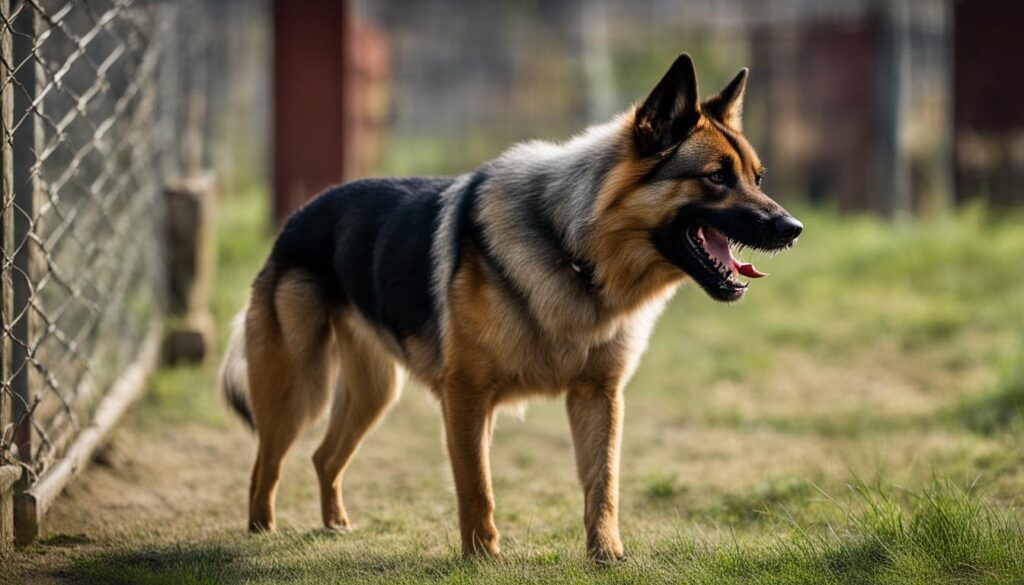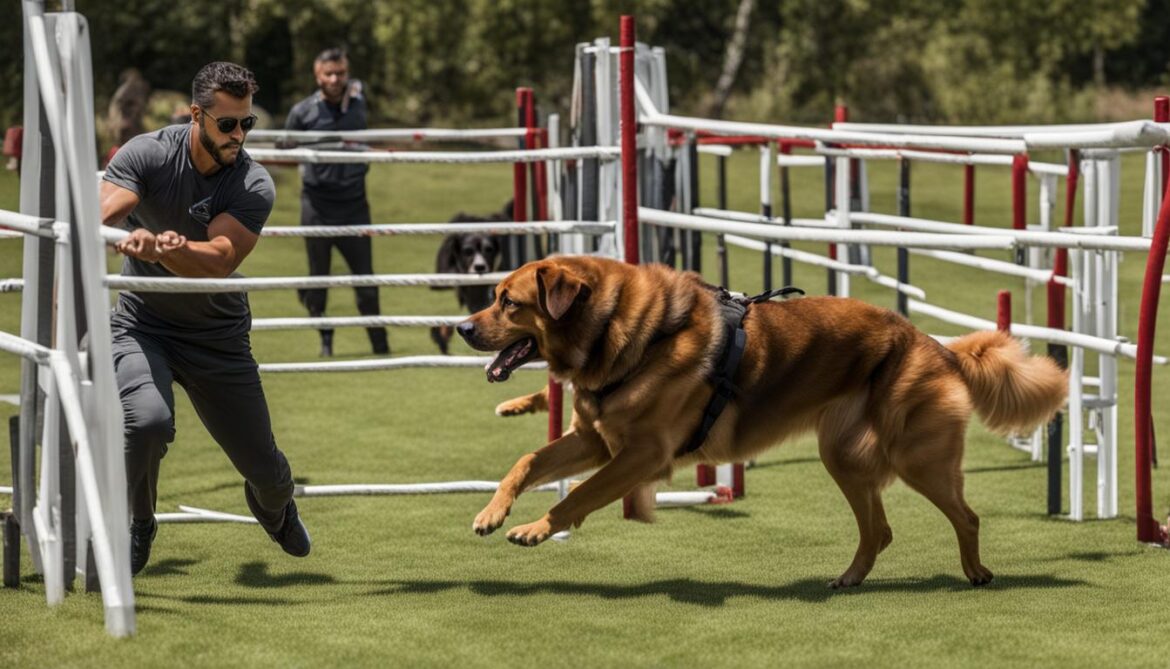If you’re a dog owner, you know how important it is to have a well-behaved pet. One of the most common behavioral issues that can arise in dogs is aggression. Whether it’s towards other animals, people, or even inanimate objects, dog aggression can be a serious problem that requires effective training methods to address. Fortunately, there are gentle and humane techniques that have proven to be successful in modifying and managing aggressive behavior in dogs.
Effective dog aggression training is crucial not only for the safety of those around your pet but also for your dog’s own wellbeing. Aggressive behavior can often escalate if not addressed, and it can cause stress and anxiety in both the dog and the owner. By learning gentle methods that work, you can ensure a harmonious relationship with your pet and a peaceful home environment.
Key Takeaways:
- Dog aggression training is important for a well-behaved pet and a harmonious home environment.
- Effective training methods can address and modify aggressive behavior in dogs.
- Aggressive behavior can cause stress and anxiety in both the dog and the owner if not addressed.
- Gentle and humane techniques have proven to be successful in managing aggressive behavior in dogs.
- With proper training, you can ensure the safety and wellbeing of your pet and those around them.
Understanding Dog Aggression and its Causes
Dealing with an aggressive dog can be a challenging and daunting task. As a responsible pet owner, you must understand the root causes and types of aggression in dogs to effectively train and modify your dog’s behavior.
Aggressive behavior in dogs can be the result of several factors, including fear, territorial behavior, and lack of socialization. It is crucial to recognize the signs of aggression, such as growling, barking, biting, and lunging, to understand your dog’s triggers and find ways to address them.
There are different types of aggression in dogs, including:
- Protective Aggression: Dogs can become protective of their owners, food, toys or their territory, leading to aggressive behavior towards strangers or other animals.
- Fear Aggression: Dogs may become aggressive when they feel threatened or scared, causing them to lash out in defense.
- Redirected Aggression: Dogs may display aggression towards an unrelated person or animal when they are unable to reach their intended target.
- Dominance Aggression: Dogs may show aggressive behavior when they perceive themselves as the pack leader.
Identifying the type of aggression is crucial to determine the appropriate training method and improve your chances of success.
Training a dog with aggression requires patience, consistency, and the use of positive reinforcement. Punishing your dog for aggressive behavior can lead to further aggression and worsen the problem. Instead, focus on rewarding good behavior and creating a positive association with the situation or stimulus that triggers the aggression.
“Aggression is not bad or good; it is simply a behavior that can be modified with proper training and care.”
If you are struggling with how to train a dog with aggression or feel overwhelmed by your dog’s aggressive behavior, seeking professional help is always an option. A professional dog trainer or behaviorist can assess your dog’s behavior, identify underlying issues, and design a customized training plan to help modify your dog’s behavior.
Remember, dog aggression can be managed and modified with proper training, patience, and consistency. By understanding the causes and types of aggression, utilizing positive reinforcement techniques, and seeking professional assistance when needed, you can help your dog become a well-balanced and well-behaved companion.

Positive Reinforcement Training for Aggressive Dogs
If your dog is aggressive, you may be feeling overwhelmed and unsure of how to deal with the behavior. Thankfully, positive reinforcement training can be a highly effective method for modifying your dog’s behavior.
Positive reinforcement training involves rewarding good behavior with treats, praise, or toys. This approach can encourage your dog to repeat the behavior, ultimately replacing negative behaviors with positive ones.
When it comes to dog behavior modification, positive reinforcement training can help your dog learn new, more acceptable behaviors. Instead of punishing your dog for aggressive behavior, you can redirect them towards more appropriate behavior, reinforcing positive actions with treats and praise.
This type of training is often best left to the professionals. Working with a professional dog trainer who specializes in positive reinforcement can help ensure that your dog is receiving the most effective training possible. A trainer can evaluate your dog’s behavior and tailor a training program that is specific to your dog’s needs.
One of the primary benefits of positive reinforcement training is that it can promote positive interactions with your dog. By focusing on positive behavior and rewarding it, you can build a strong bond with your pet and create a more harmonious household.
Examples of Positive Reinforcement Training
There are many ways to implement positive reinforcement training with an aggressive dog. Here are a few examples:
- Clicker training: Using a clicker to mark good behavior and reward your dog with treats.
- Targeting: Teaching your dog to touch an object and rewarding them for doing so.
- Crate training: Encouraging your dog to go into their crate and rewarding them for doing so.
Positive reinforcement training can take time and patience, but it can be an incredibly effective method for modifying aggressive behavior in dogs. With the help of a professional dog trainer and a commitment to consistency, you can help your dog become a well-behaved and happy companion.
Canine Aggression Rehabilitation and Therapy
If your dog exhibits severe aggression, rehabilitation and therapy programs can provide the necessary support and guidance for successful behavior modification. Canine aggression rehabilitation can range from one-on-one sessions with a professional dog trainer to specialized programs designed to address specific types of aggression.
When choosing a rehabilitation program, it is crucial to select one that is tailored to your dog’s specific needs and behavior. Some programs may focus on obedience training, while others may emphasize behavior modification techniques. It is essential to work with a professional who can assess the underlying reasons behind your dog’s aggressive behavior and develop a comprehensive plan to address them.
Types of Canine Aggression Rehabilitation Programs
Canine aggression rehabilitation programs can take several forms, including:
| Program Type | Description |
|---|---|
| Residential Training Programs | These programs involve an intensive, immersive experience where the dog lives and trains with a professional trainer. This type of program is best suited for dogs with severe aggression issues and requires a significant time commitment from the owner. |
| One-on-One Training Sessions | These programs involve working directly with a professional dog trainer to develop a customized training plan. These programs typically require ongoing sessions over an extended period and can be effective for dogs with moderate to severe aggression issues. |
| Group Training Classes | These programs involve working with a professional dog trainer in a group setting. Group classes can be an effective option for dogs with milder aggression issues and can provide opportunities for socialization and positive interactions with other dogs. |
The Importance of Seeking Professional Assistance
Dealing with an aggressive dog can be a challenging and overwhelming experience. Seeking professional assistance from a qualified dog trainer or behaviorist is essential for successful rehabilitation.
A professional can assess your dog’s behavior, identify underlying triggers, and develop a customized plan to address the aggression. They can also provide support and guidance throughout the rehabilitation process, ensuring you have the necessary tools and techniques to manage your dog’s behavior effectively.
Managing and Handling Aggressive Dogs
Dealing with dog aggression can be a daunting task, but understanding how to effectively manage and control your dog’s behavior is essential for everyone’s safety. Here are some practical tips and strategies to help you manage and handle aggressive dogs:
Stay Calm
When dealing with an aggressive dog, it’s important to remain calm and composed. Dogs can sense fear, anxiety, and stress, which can escalate the situation. Take deep breaths, speak in a calm, firm voice, and avoid making sudden movements.
Know the Triggers
Identifying the triggers that cause your dog’s aggressive behavior is crucial in managing their behavior. Is your dog protective of their food or toys? Are they reactive to other dogs or strangers? Knowing these triggers can help you avoid potential situations that may set off your dog’s aggression.
Redirect their Focus
Redirecting your dog’s attention away from potential triggers can be an effective way to manage their aggressive behavior. Carry treats or toys on walks to redirect their focus, and use positive reinforcement to reward them for good behavior.
Teach Basic Commands
Teaching your dog basic commands like “sit,” “stay,” and “come” can help you control their behavior in potentially dangerous situations. Consistent training and reinforcement can help your dog understand that you are in charge and can provide them with a sense of security.
Seek Professional Help
Dealing with an aggressive dog can be overwhelming, and seeking professional help can provide you with the support and guidance you need. A professional dog trainer or behaviorist can provide you with a tailored training plan to address your dog’s aggressive behavior and help you manage their behavior in a safe and effective manner.

Remember, managing and handling aggressive dogs takes patience, consistency, and a good understanding of your pet’s behavior. By staying calm, knowing the triggers, redirecting their focus, teaching basic commands, and seeking professional help when needed, you can ensure a safe and secure environment for both you and your furry friend.
Effective Solutions to Stop Dog Aggression
If you’re dealing with a dog that exhibits aggressive behavior, it’s essential to find effective solutions to stop dog aggression. There are several training methods, behavior management strategies, and tools that can aid in curbing aggressive tendencies and promoting more positive behaviors in your dog.
Positive Reinforcement Training
Positive reinforcement training can be an effective solution for dog aggression. This method involves rewarding desirable behavior, rather than punishing inappropriate behavior. Offering treats, praise or toys can encourage your dog to repeat good behavior and reinforce the desired response. Consistency is key; regularly rewarding good behavior will encourage your dog to display these positive behaviors consistently.
Behavior Modification Techniques
Behavior modification techniques can help dogs overcome aggression. These may include counter-conditioning, desensitization, and impulse control. Counter-conditioning involves changing your dog’s emotional response to a stimulus by associating positive experiences with it. Desensitization involves gradually exposing your dog to a stimulus in a controlled environment, slowly increasing the intensity of the exposure. Impulse control training focuses on teaching your dog to stay calm and focused in stressful situations.
Proper Management and Handling
Proper management and handling can prevent aggressive behaviors from escalating. Avoid exposing your dog to situations that may trigger aggressive behavior. Ensure your dog has a calm and secure environment, access to plenty of exercise and mental stimulation, and a consistent routine. Use a muzzle if necessary to prevent your dog from biting or injuring themselves or others. Seek professional help from a qualified dog trainer or behaviorist if you’re struggling to manage your dog’s aggression.
Medication
In some cases, medication may be necessary to manage aggressive behavior effectively. Anti-anxiety medications or antidepressants can reduce anxiety and aggression in dogs. However, medication should always be used in conjunction with behavior modification techniques and proper handling.
Conclusion
By now, you understand the importance of providing effective dog aggression training to ensure a peaceful and harmonious relationship with your furry friend. Remember to utilize gentle, positive reinforcement techniques when training and modifying your dog’s behavior.
If your dog has severe aggression issues, seeking professional assistance through rehabilitation and therapy programs can make all the difference. Implement proper management strategies to control and redirect aggressive behavior, ensuring a secure environment for everyone involved.
With patience, consistency, and the right approach, you can help your dog become a well-behaved and balanced companion. Remember to always prioritize effective dog training and aggressive dog behavior therapy to ensure a happy and healthy relationship with your pet.
FAQ
What is the importance of effective dog aggression training?
Effective dog aggression training is crucial for ensuring peace in your home and maintaining a harmonious relationship with your pet. By addressing aggressive behavior, you can create a safe environment and prevent potential harm to others.
How can I recognize signs of aggression in my dog?
Signs of aggression in dogs can include growling, snarling, lunging, biting, and raised hackles. It is important to pay attention to body language and any warning signs exhibited by your dog to address the aggression effectively.
What is positive reinforcement training and how does it help with aggression?
Positive reinforcement training involves rewarding your dog for desired behaviors, which helps to reinforce those behaviors and discourage aggressive tendencies. By focusing on positive interactions and rewarding good behavior, you can modify your dog’s aggression effectively.
When should I consider seeking professional assistance for my dog’s aggression?
If your dog’s aggression issues are severe or pose a danger to others, it is recommended to seek professional assistance. A qualified dog trainer or behaviorist can provide guidance, develop a tailored training plan, and help address the underlying causes of aggression.
How can I effectively manage and handle aggressive dogs?
Managing and handling aggressive dogs involves implementing safety measures such as using a secure leash and muzzle, avoiding triggers, and providing proper socialization and training. It is important to prioritize safety and seek professional guidance when handling aggressive dogs.
What are some effective solutions to stop dog aggression?
Effective solutions to stop dog aggression include behavior modification techniques, such as desensitization and counterconditioning, along with consistent training, providing mental and physical stimulation, and using appropriate tools like clickers or treat pouches. Identifying and addressing the underlying causes of aggression is also crucial for long-term success.
